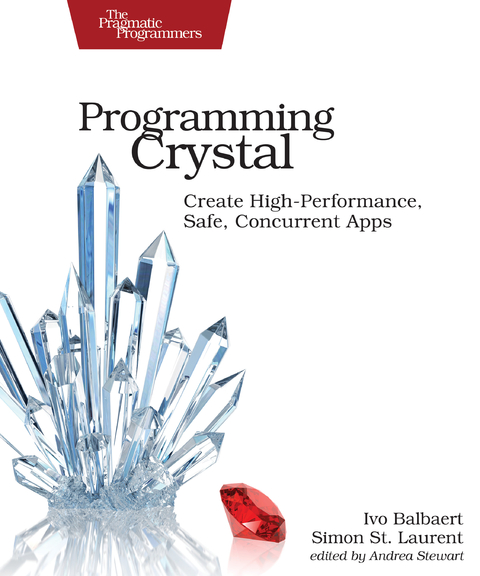
Programming Crystal
Pragmatic Bookshelf (Verlag)
978-1-68050-286-2 (ISBN)
Crystal is elegant to read and easy to program like Ruby, allowing full object-oriented development. Its compiler is powerful enough to nearly always infer the type of your variables. So you get the benefits of a statically typed language: more robust code, safety and execution speed, while still reaching high productivity in development. Null pointer exceptions as in JavaScript, Java or C#, are a thing of the past: Crystal annihilates them, just like Rust.
Explore the building blocks and design of the language, and how you can use the Crystal tool-chain to build and manage powerful applications. Harness the power of the macro system, as well as how to work with fibers and channels, making concurrency as easy as possible. Learn how to use the Kemal web framework and access databases, and how to tap the potential of existing Crystal libraries. Find the spot that Crystal fills in today's software world with real-world examples.
With Crystal, you can combine the best of both worlds: the high-level coding of dynamic languages, and the safety and blazing performance of a natively compiled language.
What You Need:
To develop in Crystal, you only need Crystal v 0.26 the latest version, a common text editor and a browser.
Ivo Balbaert is a programming teacher and Crystal enthusiast. He has a Ph.D. in Applied Physics and has worked for 25 years in the software industry as a developer and project manager in several companies. Now he combines teaching and consultancy with technical writing. He is particularly interested in elegant emerging languages for concurrency and distributed processing.
Simon St. Laurent is a content manager at LinkedIn Learning, focusing primarily on front-end web projects. He has been co-chair of the Fluent conference and of OSCON. He has authored or co-authored books including Introducing Elixir, Introducing Erlang, and Learning Rails 3, XML: A Primer, and Cookies. You can find more of his writing on technology, Quakerism, and the Town of Dryden at simonstl.com.
Preface
Getting Started
Diving into Crystal
A Programming Language for Humans and Computers
Slick As Ruby, But Way Faster
Almost As Fast As C
Speeding Up the Web
Talking to Databases
More Safety Through Types
No to the Billion-Dollar Mistake
Batteries Included
Putting Crystal to Good Use
A Company’s Story Crystallized: Red Panthers
Wrapping Up
Crystal Foundations
Using Basic Variables and Types
Variable Operations
Structuring Data with Container Types
Controlling the Flow
Using Methods
Organizing Code in Classes and Modules
Executing Code Concurrently Through Fibers
A Company’s Story Crystallized: Dev Demand
Wrapping Up
Building Blocks
Typing Variables and Controlling the Flow
Converting Data Between Types
Getting Input
Putting It Together—Converting Currencies 1
Exception Handling for Faulty Input
Chaining Methods
Getting Input from Command-Line Arguments
Using String Methods
Using Symbols as Identifiers
Using Enums
Using Regular Expressions
Putting It Together—Converting Currencies 2
Beyond Hashes and Arrays: More Composite Types
Nilable Types
Controlling the Flow and Types
A Company’s Story Crystallized: Linkfeed
Wrapping Up
Organizing Code in Methods and Procs
Passing Arguments
Returning Values
Working with Yield, Procs, and Blocks
Overloading and Multiple Dispatch
Using a Shorter Syntax for Exception Handling
Using Recursive Methods
A Company’s Story Crystallized: Duo Design
Wrapping Up
Using Classes and Structs
Converting a Ruby Class to Crystal
Structuring a Class
Applying Inheritance
Controlling Visibility
Working with Structs
Viewing the Type Hierarchy
Some Nice Tricks
A Company’s Story Crystallized: LI-COR Biosciences
Wrapping Up
Working with Modules
Combining Files with Require
Using Modules as Namespaces
Letting Modules Extend Themselves
Mixing in Modules
How the Compiler Finds Methods
Applying Built-In Modules
A Company’s Story Crystallized: Diploid
Wrapping Up
Managing Projects
Creating a Shard
Formatting Code
Documenting a Project
Writing Tests with Spec
Using External Libraries
Benchmarking Your Code
Deploying a Crystal App
A Company’s Story Crystallized: Diploid—Part 2
Wrapping Up
Advanced Crystal
Advanced Features
DRY Your Code with Macros
Low-Level Programming and C Bindings
Creating Concurrent Code
Accessing Databases
A Company’s Story Crystallized: NeuraLegion
Wrapping Up
Using Web Frameworks and Shards
Build Web Applications with the Kemal and Amber Frameworks
A Brief Tour of the Shard Ecosystem
A Company’s Story Crystallized: Kemal in Production
Wrapping Up and Afterword
Appendices
Setting Up a Crystal Environment
Working with Crystal Online
Installing Crystal on Your Machine
Compiling Code
Using Editors and IDEs
Working with Crystal Playground
Using Crystal Documentation
Wrapping Up
Porting Ruby Code to Crystal
Ruby Extensions in Crystal
Your Turn Answers
Chapter 2: Crystal Foundations
Chapter 3: Typing Variables and Controlling the Flow
Chapter 4: Organizing Code in Methods and Procs
Chapter 5: Using Classes and Structs
Chapter 6: Working with Modules
Chapter 7: Managing Projects
Chapter 8: Advanced Features
Chapter 9: Web Frameworks and the Shard Ecosystem
Appendix 1: Setting Up a Crystal Environment
| Erscheinungsdatum | 19.02.2019 |
|---|---|
| Verlagsort | Raleigh |
| Sprache | englisch |
| Maße | 191 x 239 mm |
| Gewicht | 472 g |
| Einbandart | kartoniert |
| Themenwelt | Informatik ► Programmiersprachen / -werkzeuge ► Ruby |
| Informatik ► Software Entwicklung ► Objektorientierung | |
| Mathematik / Informatik ► Informatik ► Web / Internet | |
| Schlagworte | App-Entwicklung • Crystal • Ruby • Softwareentwicklung |
| ISBN-10 | 1-68050-286-7 / 1680502867 |
| ISBN-13 | 978-1-68050-286-2 / 9781680502862 |
| Zustand | Neuware |
| Informationen gemäß Produktsicherheitsverordnung (GPSR) | |
| Haben Sie eine Frage zum Produkt? |
aus dem Bereich
